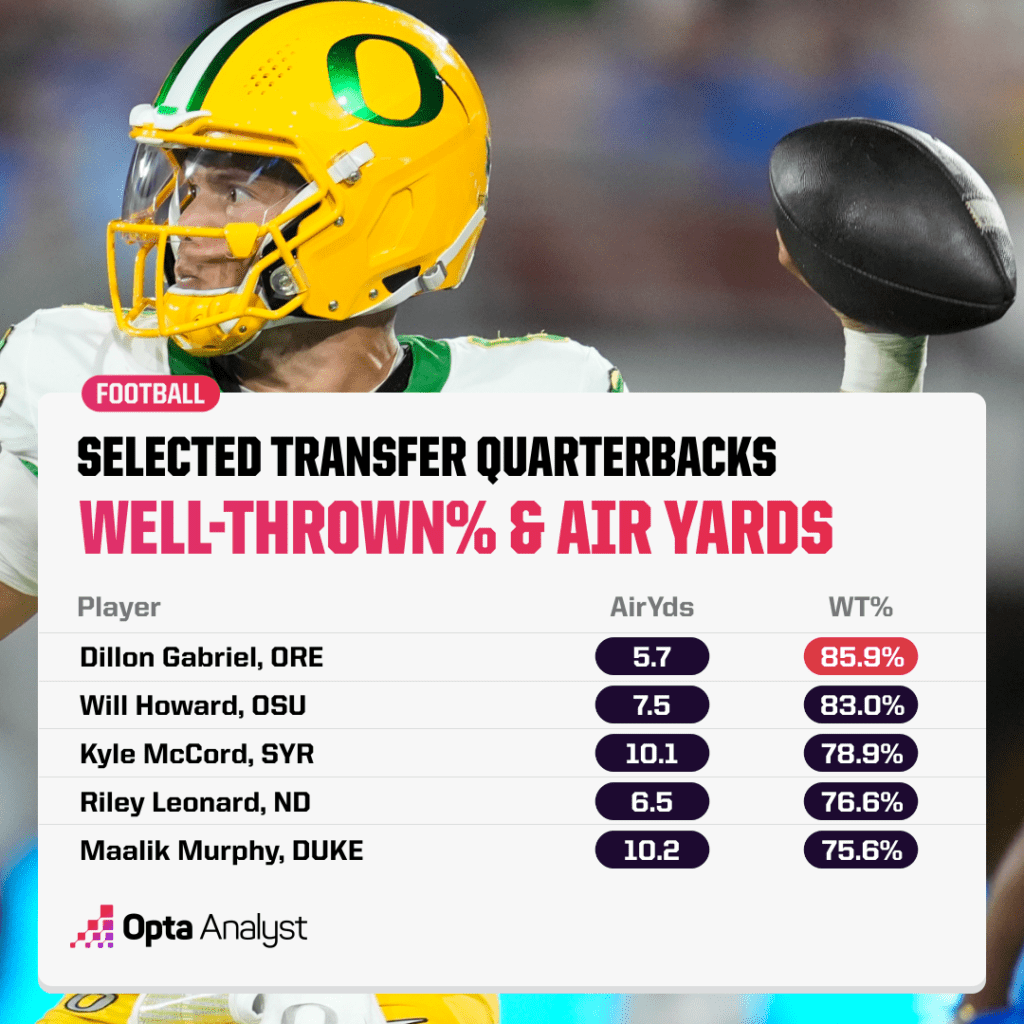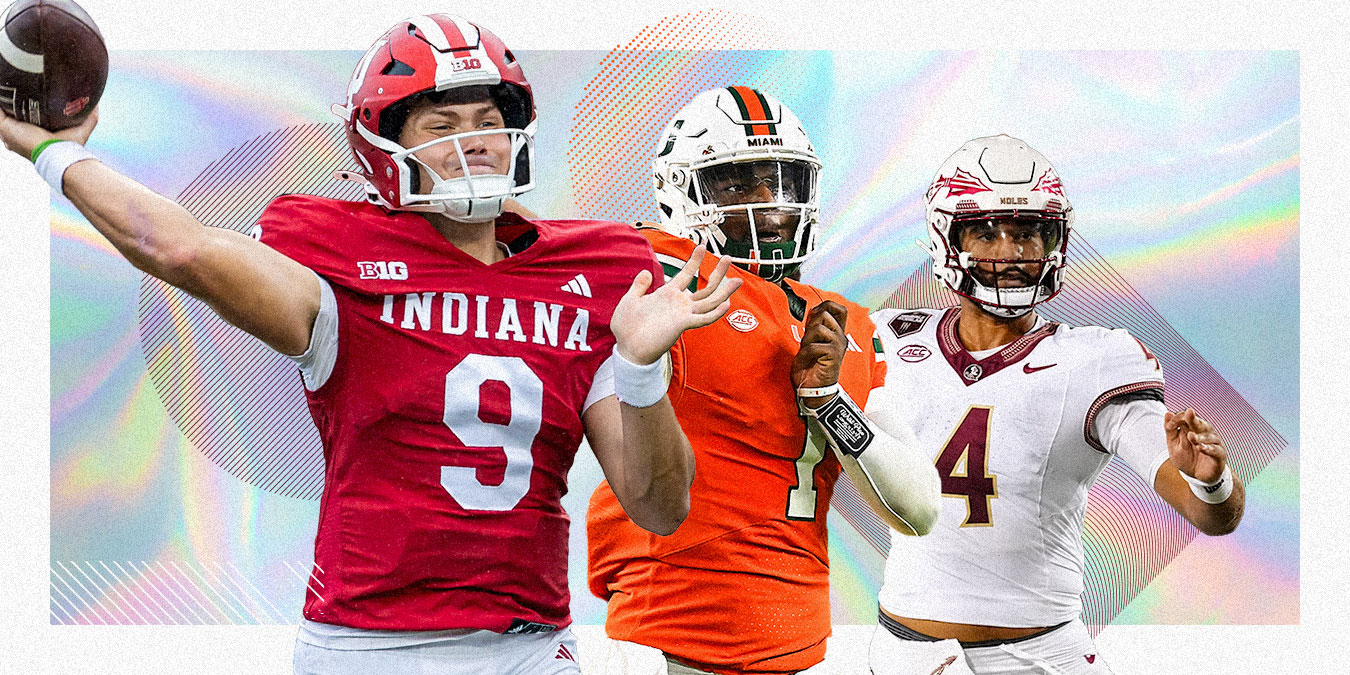This year’s transfer quarterback class has had a little of everything. Which additions look good, which look awful, and which are somewhere in between?
Transfer quarterbacks are an inherently high-risk, high-reward proposition.
Five of the six QBs to win the Heisman Trophy since 2017 did so at their second school, and every version of College Football Playoff is dotted with them.
For coaching staffs that use the transfer portal wisely and don’t need it to bail out a lack of development, the portal has been a nice way to fill short- and medium-term gaps at the most important position.
For coaches who don’t develop the position well in house, it’s been a short-term bandage at best and a self-inflicted wound at worst.
So far, 2024’s transfer QB class has a little of everything. Which additions to the QB rooms look good, which look awful, and which are somewhere in between?
Five weeks into the season, we have some hints.
The Program Elevators
A pretty good method to judge a quarterback’s effect on his program is to cross-reference him with those who have played the position before him.
Here are two unrelated sets of facts about Miami’s Cam Ward and Indiana’s Kurtis Rourke. Ward transferred from Washington State (before that Incarnate Word) and Rourke from Ohio:
- Miami has had 15 quarterbacks throw at least 100 passes in a season in the Playoff era. Those QBs’ median adjusted yardage per attempt is 7.6. Ward, so far this season, is at 12.9. or about 2.4 yards better than second-place Tyler Van Dyke in 2021.
- Indiana has had 15 quarterbacks throw at least 100 passes in a season in the Playoff era. Those QBs’ median adjusted yardage per attempt is 6.8. Rourke, meanwhile, is at 11.8, which is 2.6 adjusted yards better per throw than second-place Nate Sudfeld in 2015.
These gaps between Ward, Rourke and their predecessors will not stay this wide. Their teams will get deeper into conference play, and they won’t keep averaging 12 or 13 adjusted yards per drop back.
But Miami is 5-0 and the ACC favorite. Indiana is 5-0 for the first time since 1967 and looking like a reasonable bet to win eight, nine, or maybe even 10 games in the Big Ten.
Things are going perfectly, and the peripheral numbers look clean, too. Ward’s 77.1% well-thrown rate and Rourke’s 84.9% are both above the average for FBS passers (76.9%).
So Far, Pretty Good
Ohio State’s Will Howard and Oregon’s Dillon Gabriel are quarterbacking teams that are heavily favored to make the playoff, and neither has lost a game yet. That won’t last long – their teams play each other in Eugene in Week 7 – but both quarterbacks should have the luxury of getting comfier as the season goes on.
So far, both have been fine. Gabriel’s well-thrown percentage is third in the Big Ten at 85.9, but he’s averaging just 5.7 air yards per attempt as Oregon offensive coordinator Will Stein tries to get the ball out fast and generate yards after the catch. His 2.39 average time to throw is the third quickest in the Big Ten and reminiscent of Oregon’s approach with Bo Nix last year. (And it should be said: That approach worked well, whatever you think of Nix now as an NFL player.)
Howard has basically cruised in Ohio State’s warmup games, posing a league-best 83.3% well-thrown rate when blitzed and 83.0% overall.

Notre Dame’s Riley Leonard has looked injured all season. His weirdly lousy play bit the Irish in a loss to NIU in Week 2, which is likely to hold up as the biggest upset of the year. So far, the best thing to be said for the Duke transfer is that on his 41 designed carries, he has averaged a robust 8.4 yards.
Only two quarterbacks with as many designed runs have averaged more: Navy’s Blake Horvath (who’s running a service academy option scheme) and Washington State’s John Mateer.
Syracuse’s Kyle McCord and Duke’s Maalik Murphy weren’t able to top (or stay atop) the depth charts at blue-bloods Ohio State and Texas. But each has a big arm, and their new ACC teams have turned them loose with average target depths above 10.0 yards. They’ve each hit on some excellent throws, too.
The downside is in their interception tendencies. McCord has thrown five in four games, and Murphy has thrown four in five. McCord’s 5.1% pickable pass rate, in particular, sticks out like a sore thumb. (The ACC average is 3.4%, and Murphy is at 4.0%.)
Cleaner play would go a long way.
Promising, Just Not This Year
Michigan State’s Aiden Chiles came with coach Jonathan Smith from Oregon State, where some of us thought he was a more promising option last year than another QB who will show up later on this list. Smith evidently liked him, as he brought him to East Lansing and made him his starter right away, with three years of eligibility remaining.
It’s not worth pretending that Chiles has been some sort of star so far. He’s tossed eight interceptions in five games, tied for the second most in FBS, and even his non-intercepted passes have only been so good.
He’s averaged 5.9 adjusted yards per throw, which ranks 92nd. (Adjusted yardage penalizes interceptions, and well, Chiles’ 7.6% pickable pass rate has gotten him into trouble.) His 69.7% well-thrown rate is the Big Ten’s worst mark among qualified passers.
I am still a believer. Chiles has a serious arm, and he’s averaging a ridiculous 12.0 air yards per throw. That leads all FBS starters, and Chiles has made some throws that, if you’ve watched him, will make him incredibly hard to quit.
One of them was key in a comeback win at Maryland.
Freshman receiver Nick Marsh is another Spartan to watch.
It’s Been Ugly
NC State’s Grayson McCall was a big name in the portal, and NC State was excited to get him from Coastal Carolina. There, he helped the Chanticleers become one of the best programs in the Group of Five.
His best seasons were in 2020 and 2021. It had been a while since McCall was at his peak, and he’d been hurt a lot, and he’d been less productive in 2023 after losing his head coach and game-caller Jamey Chadwell to Liberty.
Now he’s hurt again, NC State has already turned to freshman CJ Bailey, and it’s not clear that the Wolfpack should go back to McCall even once he’s fully healthy.
McCall’s 63.5% well-thrown rate, all posted before he got hurt in Week 3, is the worst among ACC regulars. Against the blitz, McCall’s well-thrown rate is an even worse 58.6% – last in the league again.
An Utter Disaster
Everyone involved is suffering here. Fair or not, Florida State’s DJ Uiagalelei took over a promising Seminoles team and stumbled with the opportunity.
Meanwhile, FSU coach Mike Norvell has wasted nearly half a season on a third-school quarterback who won’t be around next year and hasn’t played well in the short term.
To have this bad a season and expend precious quarterback snaps on a player who isn’t part of the program’s future is as dreadful as it gets. FSU is 1-4, and Uiagalelei has been a lesser player than he was last year at Oregon State. He’s targeting open receivers just 59.2% of the time (third lowest in the ACC), which makes sense considering FSU receivers own a 64.6% open rate that is lower than what any other ACC quarterback has gotten.
Nothing good is happening, and the only solace is that Norvell finally seems poised to give backup Brock Glenn a chance. Sometimes the portal gives you a Jordan Travis, and sometimes it gives you what FSU got this fall.
Be sure to check out our MLB, NBA, NFL and college football coverage. And follow us on X and Instagram for more!
